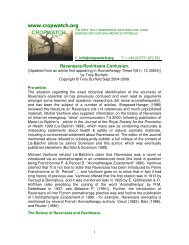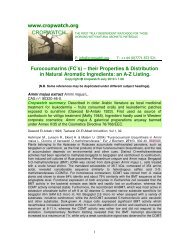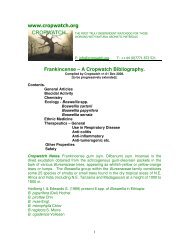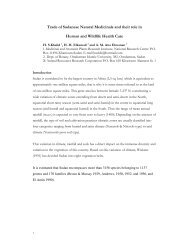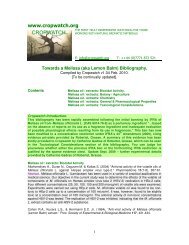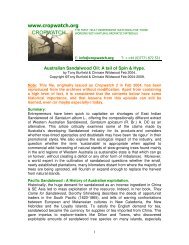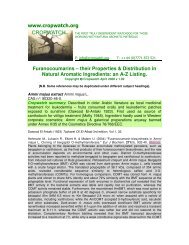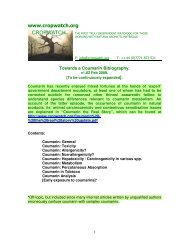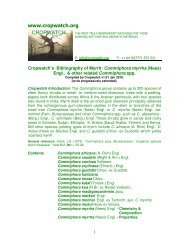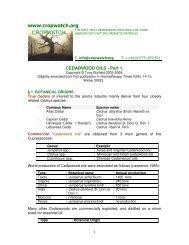Sandalwood Biblio - Cropwatch
Sandalwood Biblio - Cropwatch
Sandalwood Biblio - Cropwatch
You also want an ePaper? Increase the reach of your titles
YUMPU automatically turns print PDFs into web optimized ePapers that Google loves.
Ma G.-H., YueMin H., JingFeng Z., FuLian C (2005) "Study on semi-parasitism of sandalwood<br />
seedlings." Journal of Tropical and Subtropical Botany 13(3),233-238. Abstract. Semi-parasitism<br />
of sandalwood (Santalum album) seedlings was studied on the basis of the propagation of the<br />
different host plant species. <strong>Sandalwood</strong> plants can grow normally without host plant during its<br />
seed germination and early seedling stage. However, the subsequent growth needs roots of the<br />
host plant. Results indicated that the host plant species had a significant impact on the growth of<br />
sandalwood seedlings and their root haustoria as exhibited by the differences in haustorium's<br />
number, size and adhesiveness. Host plant species such as Hibiscus rosa-sinensis and<br />
Phyllanthus reticulatus were found as good host plants for the growth of sandalwood seedlings.<br />
<strong>Sandalwood</strong> roots lack root hairs, but its vessels were well developed, which are suitable for<br />
absorption of water and nutrients from the host's roots. The semi-parasitism of sandalwood on<br />
Hibiscus roots was also investigated.<br />
Ma G-H. & Bunn E. (2007) "Embryology and pollination trials support dichogamy in Santalum<br />
album L." <strong>Sandalwood</strong> Research Newsletter 23 (Oct 2007) Abstract. Embryo development and<br />
pollination trials were studied in Santalum album L. The formation of the male (microspore) and<br />
female (megaspore) tissues in the same flower were synchronized during the early stages of<br />
flower-bud development. How-ever, at anthesis when pollen was mature, the megaspore had<br />
developed only to the stage of a 1-2 nucleate embryo sac. The development from 2-nucleate<br />
embryo sac to matured 8-nucleate embryo sac lasted up to 10 days. These results indicate<br />
thatthe flower of S. album is dichogamous where the pollen matures before the embryo sac.<br />
Following fertilisation of the ovule the endosperm developed prior to division of the zygotic<br />
embryo, and 1-3 embryos and endosperms were formed in the samefruit. Seed-set resulting from<br />
open pollination was less than 3%. No seed set was observed when inflorescences were<br />
coveredwith a bag; however artificial pollination increased fruit set to14%. Mature seed usually<br />
germinated to produce one seed-ling, but two- and three-seedlings from one seed were also<br />
observed at low frequency<br />
Li Y. (1997) "Preliminary studies on grafting of Santalum album." Zhong Yao Cai 20(11), 543-545.<br />
Abstract: With the purpose of propagating high production Clone of Santalum album, the best<br />
season and practical method of grafting, and the selection of shoots for scion are studied. The<br />
preliminary results show: The best season for grafting in Guangzhou District occurs from June to<br />
October, when the daily mean temperature is over 25 degrees C, the side graft is recommedable;<br />
the scion from 1-5-year old young trees is much in favor for grafting than that from adult trees. In<br />
the right condition, side grafting of Santalum album has had up to 80 percent success rate.<br />
Lin L., Wei M., Xiao S., Xu X., Hu Z., Qiu J., Cai Y., Lu A., &Yuan L. (2000) "[The influence of<br />
external stimulation on content and quality of volatile oil in Lignun Santali albi]" Zhong Yao Cai.<br />
23(3), 152-4. Abstract. The authors analyzed the quality of Ligmum Santali Albi formed by the<br />
external stimulation of hormone and windburn by GC-MS-DS. The results showed that the<br />
content of volatile oil is 2.34% in the heart wood formed in 10 years tree age of Santalum album<br />
(SA) after 2 years stimulation continuously with a definite concentration of hormone, which is near<br />
to the 25 years tree age of SA in the same place. The GC-MS analysis showed that the content of<br />
santalol and other chemical components in volatile oil are similar to the 25 years tree age of SA. It<br />
is indicated that a definite concentration of hormone stimulated the SA may shorten the formation<br />
of the heart wood. The heart wood can be also formed by the broken branches after 2 years<br />
windburn, but its content of volatile oil is only 1/2 of the heart wood formed by hormone<br />
stimulation.<br />
Wei M, Lin L, Qiu JY, Chai YW, Lu AN, Yuan L, Liao HF, Xiao SE. (2000) "[Wind-damage effects<br />
on quality of heartwood of Lignum Santali Albi]" Zhongguo Zhong Yao Za Zhi 25(12), 710-3.<br />
Abstract. OBJECTIVE: To evaluate the wind-damage effects on quality of heartwood of Lignum<br />
Santali Albi. METHOD: GC-MS, TLC and pharmacodynamic test. RESULTS: The content of<br />
volatile oil from heartwood of Wind-damaged Lignum Santali Albi is 1.42%; the content of various<br />
components in the oil and the chromatography of different extracts are similar to those of<br />
reference drug and 25 years old trees. CONCLUSION: Wind-damage should accelerate the<br />
formation of heartwood of Lignum Santali Albi without influence on its quality.<br />
22





